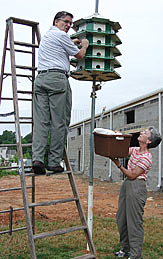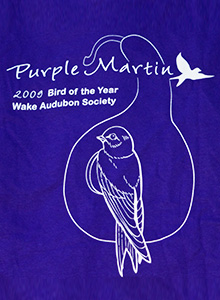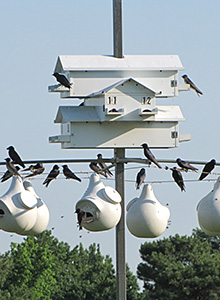
Purple Martin nest “apartment”
Wake Audubon Society began working with the North Carolina State Museum of Natural Sciences and the Purple Martin Conservation Association in 2004 to establish new breeding sites for Purple Martins within Wake County.
Purple Martins (Progne subis) are the largest member of the swallow family in North America, measuring 7 1/2 inches (19 cm) long and weighing 1.9 ounces (55 grams). Three races (subspecies) are recognized: Progne subis subis breeding in eastern North America and eastern Mexico; Progne subis hesperia breeding in the deserts of Arizona, western Mexico, and Baja California; and Progne subis arboricola breeding along the Pacific coast of the United States and Canada, and in the Rocky Mountains. Purple Martins spend the non-breeding season mostly in Brazil, and migrate to North America to nest. Most folks are quite familiar with this species, which in the eastern U.S. is now wholly dependent on human-supplied nest houses.
Due to this dependence, the above entities have agreed to work together to expand the number of nest site locations. In addition, the long-standing colony of nesting Purple Martins at the junction of Western Boulevard and Buck Jones Road (behind the Hardee’s Restaurant) had to be dismantled in 2005, due to new building construction. We hoped that birds from this site would move to some of the new sites.
John Gerwin and Susan Campbell from the Natural Science Museum banded a large number of nestling martins at the Hardee’s colony, in 2004 before the construction took place. We used the color red for the bands we placed on birds. We did find a few red-banded birds later on at the new NCSU nest site – the new nest locations are described next.

Purple Martin, 2009 Bird of the Year
A Purple Martin nest “apartment” was placed at Anderson Point Park in early 2002, with no “lessees” moving in yet (although a few birds have inspected). We began broadcasting dawn songs in March 2006 in the hopes of attracting male scouts. As of May 2006, there has only been one individual observed at the Anderson Point Park houses – for some reason (and this does happen), martins are not finding the Anderson Point location attractive. Martin housing units were erected at three new sites in west Raleigh; in 2003 at the NCSU University Club, in 2004 at the Prairie Ridge Ecostation property of the NC Museum of Natural Sciences, and on property of the NC Museum of Art. Birds began occupying the new gourds at the NCSU University Club that first spring and then expanded into unfilled cavities in 2004. Purple Martins have occupied the site ever since. Houses were erected a bit too late in the spring at the other facilities; however, Prairie Ridge hosted a small colony in 2005. They did not return in 2006, but have returned each year since. For the next several years, young were produced but eaten by a stealthy Black Rat Snake. This snake was able to get around various baffles put in place. In 2013, the martin colony had expanded to at least 6 pairs, and new baffling kept the snake on the ground. Thus that year, numerous young fledged. In 2011, a martin nest array was placed at a new city park, Horseshoe Farm Park. Some birds used the nest array in 2012, but not in 2013.

Purple Martin nest “apartment”
We have banded nestling birds at the NCSU Faculty Club, and NCSM Prairie Ridge colonies to attempt to monitor any inter-colony movements, and acquire data on other life history traits (how long do they live here; how faithful are the birds to these new sites, etc.). In 2004 we banded some nestlings at the “Hardee’s” site and as mentioned, we later saw some of these birds at the Faculty Club – which confirms that some of the displaced birds moved to the new housing. We also noted a banded bird at Prairie Ridge in 2013 – which tells us that one of the nestlings we banded in a previous year had returned to the general area, but specifically to nest at Prairie Ridge.
2009 was declared by the Year of the Purple Martin by Wake Audubon. See the Life History Notes below for more details about this celebration and Purple Martin natural history.
PUMA’s are champion migrants, flying to northern South America each year, and then returning to our area long-before other “long distance” migrants. Scouting males can be seen here in early March, whereas most other such migrants won’t be here till mid-April. Martins are part of the swallow family, whose 89 species are found worldwide. In other areas, martins still nest in natural cavities. In the eastern U.S., however, PUMA’s have become almost wholly dependent on artificial houses. Wake Audubon is working with the Purple Martin Conservation Association to establish new colonies in this area. Many PUMA’s spend the winter in Venezuela, where the spraying of insecticides is a threat to the population. Read on for additional details about the annual cycle of one of America’s most popular birds.
Martins are fine migrants and aerial feeders. Now they are cruising the airways of much of South America, in lowlands east of the Andes and mostly north of the Tropic of Capricorn. There they feast on a “bugfet” of flying insects over rainforests, clearings, and agricultural areas. PUMA begin their migration north in January, arriving in the Gulf Coast region by mid-month.
Early-arriving males, called “scouts,” are seen in NC by late February. Contrary to popular folklore, “scouts” are not looking for new breeding sites for their flocks. They are older birds, the first ones to arrive in, or pass through an area on their way back to their previous year’s nesting sites. They seldom switch to new housing. Younger sub-adults are the birds that colonize new sites. These often return later than “full” adults, and in our area can colonize a new site as late as the end of May. East of the Rockies PUMA’s are totally dependent upon human-supplied nest boxes. Out West they still nest the old-fashioned way, in woodpecker cavities.
Native Americans hung up empty gourds for Purple Martin before Europeans arrived in North America. For more information, visit the Purple Martin Conservation Association.
Martins re-appear in NC by late-February, but most reports of “returns” occur in early March. Although males generally arrive first, females are not far behind. You can track “live” at the Purple Martin Conservation Association. Upon their arrival, pair-bonds form quickly and the nesting process begins anew. Both adults assist with nest-building. Females lay a clutch of 2-7 eggs, which requires 15 days of incubation. The nestlings are tended to in the nest for up to 30 days, after which they are ready to strike out on their own, as fledglings. Adults will continue to care for the young for 2-3 more weeks. At the old “Hardees” colony site in 2004, we were banding some 15 day old nestlings on April 16. The “Prairie Ridge” birds typically have such young in June, indicating this site was founded by younger birds, which typically arrive later in spring. To see an animation of the development of a young martin, visit the Purple Martin Conservation Association.
Martins are aerial foragers, consuming flying insects. But mosquitoes are not a large part of their diet, much as we wish they were! Martins generally forage much higher than where mosquitoes fly. Adult Martins weigh about 55g or 2 ounces.
By now most nesting has finished. Juveniles begin catching insects on their own by the 5th day out of the nest. As soon as nesting is complete, martins of all ages begin to flock up, as they are a very social animal. The Mann’s Harbor Bridge in Manteo is host to one such flock. By mid-July birds begin to gather there. By early August approximately 100,000 birds use the bridge under which they roost each evening. It is a spectacular site to witness, in late July or early August. There is a flock at Lake Murray, SC, that has been estimated to contain over 700,000 birds. When these flocks disperse in the early morning, they are easily seen on radar. Many birds will begin to depart our area by mid to late August. Little is known about the exact migration route, but martins appear to follow the coast and beaches closely. Adults also begin a complete molt at this time. So for weeks the birds will be trying to fatten up in preparation for a long migration, and begin their molt. The molt is protracted and will not be complete until the following February. In fact, the molt is “interrupted” while the birds migrate, then resumed and finished on the wintering grounds.
The cycle is now complete, as these birds have returned to the land from where they likely evolved, South America. Now is a good time to clean out your boxes. I was reading some older literature and found arrival dates, which I thought I would compare to today’s web-based tracking dates. New Orleans: 1-9 Feb (old), southern Louisiana: mid-Jan to mid-Feb (2009); Falls of the Ohio (Louisville, KY): 15 March, vs. Versailles, KY, 19 March 2009; St. Genevieve, Missouri: seldom <10-15 April, vs. Perryville (just south) 4 April, and Bloomsdale (just west) 16 April 2009; Philadelphia, 10 April, vs. Gettysburg, 23 March and 27 April, 2009; Boston, 25 April, vs. Rehoboth (just south), MA, 22 April.
What’s interesting is that the “old” data come from J.J. Audubon, from the early 1800s. Thus, in the big picture, things haven’t changed much for martin migration, it appears. It’s also quite interesting to me that Audubon was able to acquire these data without the use of phones, cars, or Internet. During his travels, Audubon of course paid attention to many details, and I leave you with the following observation: “Almost every country tavern has a Martin box on the upper part of its signboard; and I have observed that the handsomer the box, the better does the inn generally prove to be.”
